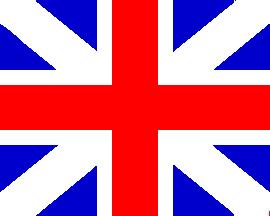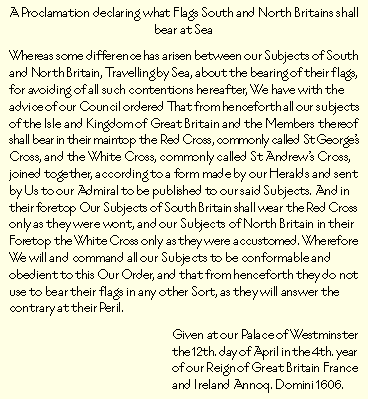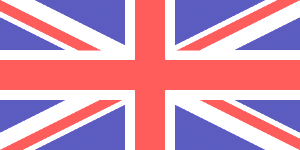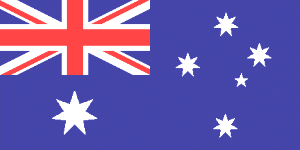Regardless of the
arguments for and against keeping the flag I believe that it goes
without saying that one needs to understand what the flag stands for
before you can decide your position. This page sets out the
history of the Union Jack which seems to be the focal point of dispute
as far as the Australian National Flag is concerned and then it shows
how a British Blue Ensign was defaced to provide our flag.
|
The History and
meaning of the UNION JACK |
 |
The Union Jack is a trans-national flag full of
historical significance.
It represents the union of different countries
and the growth of a family of nations whose influence extends far beyond
the British Isles. This far-reaching influence is still seen today in
the incorporation of the Union Jack in other national flags such as that
of Australia. The British flag is called the "Union Jack", an
expression that needs to be explained.
The Union Jack is a fine expression of unity as well
as diversity. The British flag incorporates the national symbols of
three distinct countries, England, Scotland and Northern Ireland. In
fact its name "Union Jack" emphasises the very nature of the
United Kingdom of Great Britain and Northern Ireland as a union of
nations. The flag is also known by another name, this too, emphasising
the idea of union: the "Union flag", perhaps a less common
term but a little more precise. The countries comprising the British
Isles are not inward-looking or isolated states with an insular
mentality; together they constitute a powerful union that has spanned
centuries. Recent devolution that gave Scotland its own Parliament and
Wales its own Assembly has also emphasised the importance of individual
national identities within the union without affecting the essential
unity of Great Britain. On the contrary, it has strengthened it.
Recognition of, and respect for national identities are an essential
ingredients for effective union. The Union Jack symbolises all this:
respect for individuality within a closely knit community.
The "Union Jack" or "Union Flag"
is a composite design made up of three different national symbols:
The cross represented in each flag is
named after the patron saint of each country: St. George, Patron Saint of
England, St. Andrew, Patron Saint of Scotland and St. Patrick, Patron Saint
of Ireland.
-
England -
vertical red cross on a white field - dates from the time of Crusades
and the decoration of the tunics covering the chain mail of the
crusaders.
-
Scotland -
Also known as the Saltire. Diagonal white cross on a dark blue
field (this colour was adopted for the general background of the Union
Flag) - origin obscure, and probably nothing to do with the apostle
Andrew.
-
Ireland
- diagonal red cross on a white background - nothing to do with
St Patrick as he was not a martyr and has thus never been associated
with a cross - added to the Union Flag in 1801 in such a way that neither
the red or white diagonals are seen to be superior (on the hoist side
the white is superior, on the fly side the red is superior.
The image below provides the idea of the union of the
three flags forming one unified, trans-national Flag.

No mention has been made of the Welsh
flag.

The Welsh dragon was not incorporated into the Union Flag because
Wales had already been united to England when the first version of the
Union Flag was designed in 1606. It is, however, in common use today.
THE HISTORY OF THE
UNION JACK
The first step taken in the creation of
the flag of Great Britain was on 12th April 1606. When King James V of
Scotland became king of England (King James I) it was decided that the
union of the two realms under one king should be represented symbolically
by a new flag. Originally It consisted in the red cross of England
superimposed on the white cross of Scotland on the blue background of the
Scottish flag as in this illustration:

Thus we have the first flag of the Union called, in
fact, the "Union Flag".
-
The flag raised by Governor Philip on
the first Australian Day, 26 January 1788, was this version of the
Union Jack.
-
Note that the blue was lighter then
than now and that the flag was closer to square. Over the years flags
have got longer and the story is that the Admiralty made the dye
darker so the flags would last longer before having to be replaced
because of fading.
What was meant to be a symbol of unity
actually became a symbol of international controversy. The English
resented the fact that the white background of their cross had disappeared
and that the new flag had the blue Scottish background. On the other hand
the Scottish resented the fact that the English red cross was superimposed
on the Scottish white cross!! The old adage says you cannot please
everyone but this first version of the Union Flag seemed to please no-one!

However, the flag was usually restricted
to use at sea until the two kingdoms of Scotland and England were united
in 1707. It was most probably from this use at sea that it got the name
"Jack" ("Union Jack"). It was usually flown at the bow
end of the ship, from the jack staff.
An attempt was made to modify the flag
under Oliver Cromwell. A harp was placed in the centre, representing
Ireland. However, the original design was restored along with the
restoration of the monarchy in 1660.
The flag continued to be used in its
original form until Jan. 1, 1801. At that time, with the union of Ireland
and Great Britain, it became necessary to represent Ireland in the Union
Flag and so the cross of St. Patrick was include thus creating the flag as
we now have it. When the southern part of Ireland gained its independence
in 1921 and became the Irish Free State no alteration was made to the
Union Jack.
The name "Union
Jack" became official when it was approved in the British Parliament in 1908. It
was stated that "the Union Jack should be regarded as the National
flag".
As I had been told that the
Union Jack was not an official flag and had never been approved by
Parliament I made enquiries. This is the answer I got . . .
Dear Mr Harris
There is no such legislation in the United Kingdom. The reference
was to the then Home Secretary's announcement in the House of Commons, to
the effect that the flag should be so regarded.
There is no flag legislation in the United Kingdom, other than the several
Merchant Shipping Acts. These latter only cover flags used by
commercial and other privately-owned vessels afloat.
The Union Flag has always been a royal flag, representing the union of the
three countries of the kingdom. It was seldom seen on land until the
Great Exhibition of 1851. Then people started to use it on land more
freely. This was given further popularity by the Golden Jubilee of
1887 and the Diamond Jubilee ten years later. Soon after that came
the Anglo-Boer War and the flag was used as an expression of patriotism
again.
By then the custom had arisen of hoisting it on land over private
buildings. The debate (a very short one) of 1908 was to question
this practice. The Home Secretary (one presumes with the knowledge
and consent of the then King Edward VII) stated that the flag could be so
used. This was repeated by King George V on the occasion of his
Silver Jubilee in 1935.
The flag remains a royal flag, used by the citizens with permission of the
sovereign. Technically that permission could be withdrawn, although
it is hard to imagine the circumstances when this would be done. On
the bicentenary of the flag in 2001, the Flag Institute lobbied Parliament
to have the flag at last adopted officially as the flag of the United
Kingdom on land. Our efforts were completely ignored.
I hope that this information assists you, although I recognise that a
specific Act of Parliament would have helped more. Alas no such Act
exists.
Yours sincerely
Michael Faul
The Flag Institute
York, England.

Take all of that and come
up with the British Blue Ensign that looks like this

add 5 stars to
represent the Southern Cross and a 7 pointed star to represent the States and
Territories of the Federation (1 per State and 1 for the Territories as a
group)

and "Hey Presto" you have the
Australian Blue Ensign which later became the Australian National Flag
|









